Radiator replacement: threaded connection and welding,
Old buildings rarely receive the attention of public utilities and major repairs, especially the reconstruction does not exactly threaten them for a long time. But you want heat at any time, so overgrown radiators change or increase often on their own, after having previously coordinated their actions with certain authorities. Replacing radiators on gas welding does not belong to the category of long and dirty and can be carried out in a matter of hours.
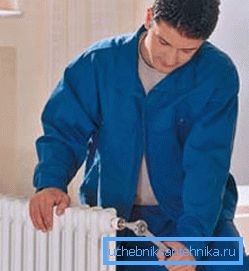
Radiators in law
Before talking about obsolete cast-iron batteries, about the urgent need to replace them, I would like to touch on the legal side of this issue. If the owner-master and is free to modify the heating devices every season in his possession, then the residents of state-run high-rise buildings are deprived of this pleasure. This is not surprising - the intertwining of communications contributes to the close relationship and the same dependence on each other of the apartments and their owners.
So that your intentions to replace the radiator of the last century with a technical novelty were not perceived as an attempt on the personal safety of your neighbors, you should strengthen your actions with the regulatory framework.
So, in connection with the replacement of heating devices, the corresponding questions arise:
- How not to disturb the heat balance at home?
- Who owns the heating devices in a single apartment?
- Where to turn on the issue of dismantling, replacing radiators or changing their power?
- Who has the right to carry out such work?
If it is short for each question, then the concept of heat balance can be expressed by the formula heat input = heat loss, while respecting which the optimum temperature is maintained in the building. The increase in the heat transfer surface of the batteries, their configuration can “snatch” a large proportion of the heat from the main line, depriving the neighbors.
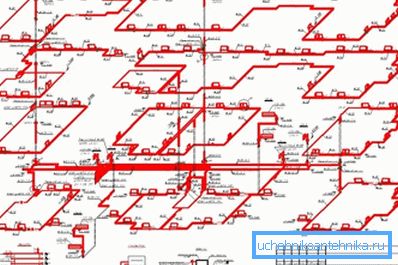
On the issue of belonging, heating devices located in the apartments are included in the general house or collective property of the house. It is logical that any changes in this direction should be discussed at the general meeting of the owners of this house according to Art. 44, 46 LCD RF.
According to Order No. 37 of the Ministry of Land Construction of the Russian Federation of August 4, 1998, the replacement of a radiator in an apartment is considered to be a completely legal procedure and does not require a permit. It is considered mandatory control by the service organization, which has the right to force the owner to dismantle unnecessary sections, if they were arbitrarily added.
If the people's assembly is not against it, the owner of the apartment can do the renovation, but by the appropriate organization. The question of the identity of the old radiators to the old one, their transfer, as well as the change in the number of sections is subject to agreement. The progress of work is also controlled by the service organization.

Note! It is logical to carry out such work shortly before the onset of the heating season. So you will have the opportunity to test the tightness of the joints and have time to fix the leaks before putting the system into action.
Yourself master - complete battery replacement
Homeowners can consider themselves lucky, because they can put radiators of any configuration, choose the best way to connect without the grace of higher authorities.
For the installation of the device with your own hands, you will need the necessary tools, some of which are very specific:
- keys set;
- Angle grinder or grinder;
- perforator;
- Lerka - a device for threading;
- vertical level (plumb line) and horizontal;

Note! If the old battery was connected to the pipeline with the spike, the need for the meter would disappear - using the same sponge you can perfectly connect the new one.
- gas welding (as an option), however, the price of future repairs will be higher, because just disassemble the connection will not work.
Threaded connection
To begin with, it will naturally be necessary to dismantle the old battery of heating (we assume that the drives are in normal condition):
- On the upper and lower eyeliner, twist the lock nuts to the beginning of the thread.
- With a plumb line or level mark the vertical line on the pipe, leaving at least 1 cm of thread.
- Grinder cut pipes on the marked strips.
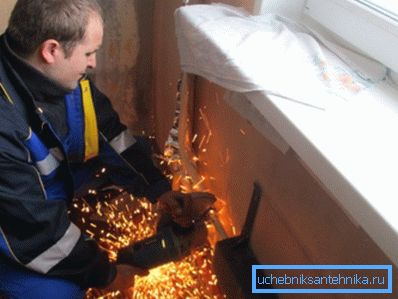
Note! If the sections on the pipe are curves, then connecting the new battery to them will become impossible.
- Remove the burrs by “driving out” the locknut on it, and trim the cut.
- Remove the radiator.
- Remove brackets.
Having cleared the workspace, the second stage begins - directly replacing the radiator in the apartment:
- On pipelines, install taps with a detachable connection, using tow as a compactor. The thread is painted over with paint (not water-based), the tow is wound from the edge, turned over again and the crane is turned on.
- In the internal threads on the battery case (2 pieces on each side), the futorks are screwed onto the rubber / paronite seals.
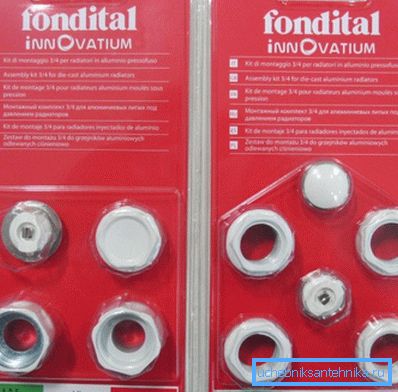
Note! It is better to buy a kit with bushing nuts, so as not to get lost in the types of thread.
- In places where the radiator is connected to the pipeline, install American counterparts.
- From above to establish Mayevsky's crane, from below - a cap.
- Raise the device, aligning the future joints of the crane with an American. For stability down you can put a wooden block or a brick.
- Mark space for brackets.
- Remove the battery and strengthen the hooks in the wall.
- Suspend the heating device and check its level by level.
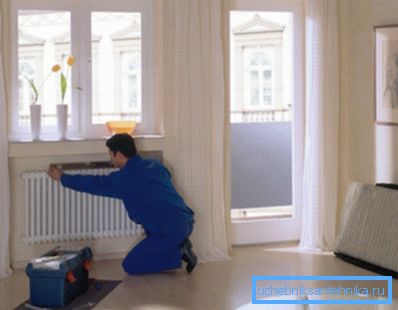
- Tighten the plug connection with a wrench.
Weld joint
Such a connection is considered more reliable than a threaded one for several reasons:
- Well resists high pressure;
- High degree of tightness;
- Does not need seals;
- Aesthetic appeal.
Note! Welding should be carried out only by a qualified specialist with permits. If the work is carried out in an apartment, then before replacing the radiator using welding, it is necessary to obtain a special permit for this.
It is not necessary to remind that before work begins, water is drained from the system, and the further scenario is in many ways similar to the previous one:
- Remove the old heating device.
- Spend his packing - tighten the threads, tighten the nuts, American women install, Mayevsky's crane in place.
- Fix the device and connect the American with eyeliner.
- Heating pipes to lead to the riser and weld.

Replacing sections
A remarkable property of aluminum sectional heating devices consists in their design - sections, the number of which can be changed, reducing / increasing the heat transfer area. The metal itself is lightweight, which significantly reduces the effort during installation work.
Adding or replacing an aluminum radiator section will require the following tools and materials:
- Radiator key.
- Radiator gaskets - connections with two-way threads.
- Paronitic / silicone gaskets.
Note! Do not replace special gaskets with any others to avoid leaks.
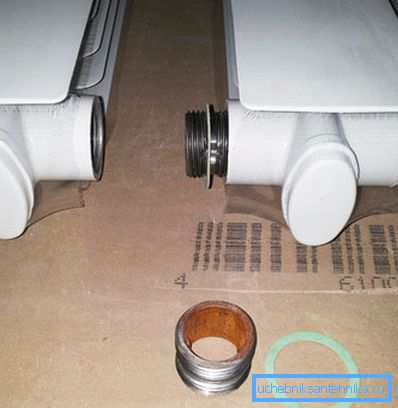
It is better to mount the segments on a horizontal surface, placing the device "facing" towards you:
- Remove plugs from the connecting holes in the ends.
- Wear a gasket on the smooth part of the nipple.
- Screw the nipple 2-3 turns into the collector.
- Lightly pressing, combine the added section with the nipple.
- The key to tighten the nipple - its right-left thread will tighten both parts of the battery. It is necessary to tighten both nipples in turn and for the same number of turns to avoid skewing.
The proposed instruction remains the same for all types of sectional radiators, you only need to take into account the peculiarities of the metal from which it is made. So, when replacing the cast-iron section, it is especially important to evenly tighten the upper and lower nipples. The fact is that the cast iron practically does not work for stretching, therefore, microcracks can form, through which water will flow during operation.
Note! In order to avoid possible leaks, it is impossible to clean the surfaces with which the sealant will be pressed against with a sandpaper / file.
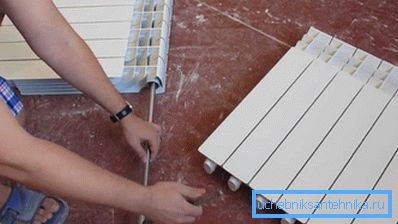
Prefabricated radiators are advantageous in that they simply allow replacing a failed section. But in the case of one-piece heating devices, replacement of the core of the radiator is impossible, it is necessary to buy a new heating appliance.
Cost effectiveness
Independent replacement of radiators is not only easy, but also very profitable.
Specialists highly value their work, of course, the rates are highly dependent on the region, the complexity of the work and the specialist's requests, but on average they are:
- connecting the battery will cost about 500-600 rubles (this is only for submission), the connection will also round off the return to 1000;
- It is unlikely that someone will take down the old cast-iron battery less than at a rate of 10 sections / 200 rubles. Installing a new one will cost more - about 10 sections / 400 rubles;
- installation of lightweight bimetallic radiators will cost about 250-350 rubles (this is without regard to its connection to the pipes of the heating system).
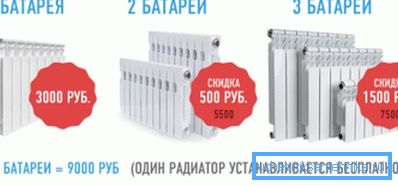
Note! Sometimes stores offer free dismantling of an old battery and installation of a new one. This is a good way to save money.
Summarizing
Replacing radiators is quite a feasible task for everyone, even a non-expert. To do this, simply follow the suggested recommendations (and do not forget about the legal side of the issue - for residents of multi-storey buildings). The result will not differ from the work of a specialist, and an additional bonus will be saved a few thousand rubles.
The video in this article shows the process of replacing a cast iron radiator.